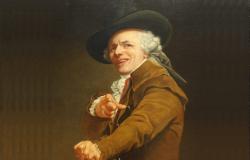The March Foundation in Madrid celebrates the artist’s centenary with a selection of the main jewels from the Cuenca Museum of Abstract Art
Alfred H. Barr, the first director of MoMA in New York, had just finished his time as head of the museum’s collections when he visited Cuenca in 1967. He who is probably the most influential cultural manager of the 20th century, who invented the contemporary museum institution, found in the city of La Mancha, hanging from a cliff, “the most beautiful small museum in the world.” This is how he defined it during a meal with eThe artist and collector Fernando Zóbel, after visiting the spaces of the Spanish Museum of Abstract Art that it inaugurated a year before.
The works that Zóbel had been acquiring from artists of his own generation and that were expressed through the informalism and abstraction, were distributed along the walls of the hanging house that the mayor of Cuenca had given him. «There was no modern art museum in the late 60s in Spain, That’s why it had to be created,” explains Manuel Fontán del Junco, director of museums and exhibitions at the Juan March Foundation and who would also curate the exhibition dedicated to that great little museum, which borrows Barr’s phrase as its title.
Eduardo Chillida, Antoni Tàpies, Jorge Oteiza, Pablo Palazuelo, Néstor Basterretxea, Antonio Saura, José Guerrero, Gustavo Torner or Eusebio Sempere They were young people between 30 and 40 years old with a very solid language, but little prospect of showing it in a country where there was no institutional network. During the Franco regime, the cultural and artistic progress that was latently beginning to take shape in the country was barely visible. Until the Cuenca Museum of Abstract Art sees the light.
“It is a project carried out on the margins of the official cultural policy of the regime, which, on the other hand, had a fairly active foreign policy,” insists Fontán when referring to the soft-power Francoist regime that showed signs of openness abroad. There were important exhibitions of Spanish art at the Tate and the MoMA, awards at the Sao Paulo Biennial -a Oteiza in 1957 – and critical recognition of the Spanish pavilion at the 1958 Venice Biennale. But in Spain, the Museum of Contemporary Art of Madrid, which Antonio Fernández del Amo directed since 1951, did not have an important tour and the artists floated in a nebula until Zóbel arrives.
«The expression is very reddit renaissance man“Continues Fontán when referring to Zóbel, whose centenary of his birth is celebrated in 2024. “He is a well-read guy, he is a polyglot… He was born into a Spanish family, but on the margins of the Western world, for so to speak, in the Philippines. He dedicated himself to traveling through Europe, but then he studied at Harvard.
He learned from the great masters in the best museums in the world, he also bought art. He could afford it since he came from a great family that made its fortune in the former Spanish colony, where he returns after his world training tour. He is also interested in Asian art, from his native Philippines and beyond, such as calligraphic painting from Japan. In 1961 he settled permanently in Spain, which he had visited on several occasions. He met Gerardo Rueda in 1955 and later Saura, Martín Chirino, Eusebio Sempere, José Guerrero and Torner. They are friends and he also buys their work. Not only is he aware of the need to unite this emergence without echo, he is also a way of supporting his fellow travelers.
«As a collector, Zóbel is playing with his artist’s eye, of deep knowledge of the history of art, literature, philosophy and culture in general. And that can be seen in the collection,” according to the museum director of the Juan March Foundation, to which Zóbel donated his collection as well as his archive in 1981. “I would say that it is profoundly broad and democratic, in the sense that he is not an artist who is simply carried away by names: there are many works by creators who were not known then and who today remain secondary luxury.”
The Juan March Foundation exhibition shows how the approach towards the creation of the Museum of Abstract Art of Cuenca had more to do with that of a space self-managed by artists, a artist-run-space like those that were beginning to occur in New York at the time, but with money, rather than with a public institution. The closeness, the friendship, the awareness of making history is palpable in the enthusiasm that the artists shared as they joined the circle that formed around Zóbel. «The project was 20 years ahead of its time. “It was the main cultural experiment of the Transition.”





